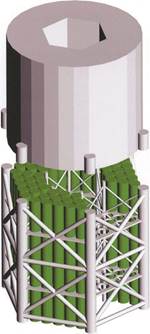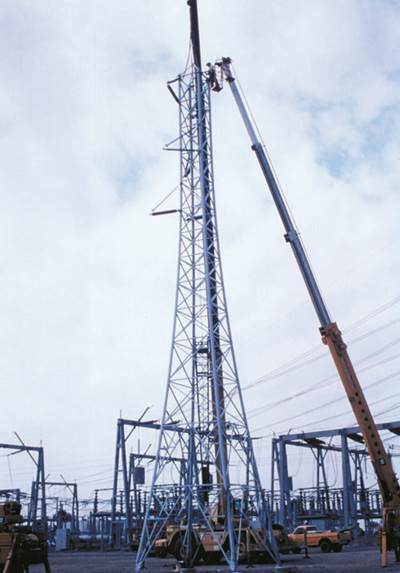All-Composite Platforms?
Gibson describes how a team representing the Centre for Composite Materials Engineering, MSP (formerly Maunsell Structural Plastics, Beckenham, Kent, U.K.) and Odebrecht Oil and Gas, a Brazilian-owned platform fabrication company, were tasked with redesigning the topside of BP’s small, minimum-facility Davy-Be
Gibson describes how a team representing the Centre for Composite Materials Engineering, MSP (formerly Maunsell Structural Plastics, Beckenham, Kent, U.K.) and Odebrecht Oil and Gas, a Brazilian-owned platform fabrication company, were tasked with redesigning the topside of BP’s small, minimum-facility Davy-Bessemer monopod platforms. Under the umbrella of the United Kingdom’s Advanced Research Partnership (ARP) collaborative research program, the group investigated the potential for weight savings with a composite design of the monopod platform, which comprised a single vertical column, supporting a three-deck topside for oil production. The redesign effort was overseen by a group of project sponsors, including Mobil and Amoco, and followed regulatory guidelines applicable to metallic structures, issued by the United Kingdom’s Health and Safety Executive (HSE). The Davy-Bessemer was chosen because of its relatively small size, which minimized the scale of large composite structure fabrication. The fact that the monopod is “not normally manned,” or visited only infrequently for maintenance simplified some design decisions related to staff accommodations and fire safety.
Initially, a “conforming” redesign was conducted, which retained the same floor dimensions and overall equipment layout as the original. Key to the design was a structure of multi-cellular interlocking beams for the decks. Each consisted of 38 pultruded square tubes, overwrapped with fabric wetout with vinyl ester resin to form a deep rectangular box beam. The beams would be interlocked laterally by means of pultruded tubes, to allow loadsharing across the elements of the structure. This allowed gaps, where necessary, between each beam to accommodate the requirement for an “open” deck in case of spillage. A similar cellular beam structure was envisioned for the vertical supports between decks. At the time the design was carried out, says Gibson, it was not possible to obtain pultruded beam sections of sufficient depth. Just a year after the initial design, however, Strongwell’s (Bristol, Va., U.S.A.) double-web beam became available.
“A sandwich panel design was rejected because, with currently available foam thicknesses, it was not possible to make a sandwich deck of sufficient depth to achieve the stiffness and strength that was required for the deck loading,” says Gibson. The “conforming” design, essentially a substitution of composite beams for steel beams, achieved a savings of 38 percent in weight and 7 percent in cost, compared to that of the original steel solution.
In an effort to show how composites could be utilized to even greater benefit, a second, “radical” design was undertaken, which allowed rearrangement and reconfiguration of decks and equipment, as long as the design maintained necessary functionality. Using a similar beam concept, the radical solution was found to be 55 percent lighter than steel and 26 percent less costly. Gibson points out that starting with a clean sheet of paper rather than copying a metallic structure allows the designer to use the characteristics of composites to best advantage. Gibson has explored a similar concept for helidecks in a study undertaken with Odebrecht and Vosper Thornycroft (Southampton, U.K.) also under the ARP umbrella. Weight reductions up to 50 percent were found to be possible, using composite cellular box beams for an all-composite upper deck and underlying support structure.
The composite monopods and helidecks have not been built. “We’re hoping for a product champion,” Gibson explains. “The monopod platform concept is intended for relatively shallow, marginal production, likely in the North Sea, if it’s built.” An advantage of the composite topside is that it is reuseable — once the production is depleted, the platform can be lifted and readily moved to another location. Gibson predicts, “Twenty years from now, these larger structures will be routine.”
Related Content
One-piece, one-shot, 17-meter wing spar for high-rate aircraft manufacture
GKN Aerospace has spent the last five years developing materials strategies and resin transfer molding (RTM) for an aircraft trailing edge wing spar for the Airbus Wing of Tomorrow program.
Read MoreMaterials & Processes: Fibers for composites
The structural properties of composite materials are derived primarily from the fiber reinforcement. Fiber types, their manufacture, their uses and the end-market applications in which they find most use are described.
Read MorePlant tour: Albany Engineered Composites, Rochester, N.H., U.S.
Efficient, high-quality, well-controlled composites manufacturing at volume is the mantra for this 3D weaving specialist.
Read MoreComposite resins price change report
CW’s running summary of resin price change announcements from major material suppliers that serve the composites manufacturing industry.
Read MoreRead Next
A Different, All-Composite Approach
Fiberglass Structural Engineering Inc. (FSE, Bellingham, Wash., U.S.A.) has patented its innovative concept for a hybrid fiberglass and steel platform. Approximately 50 percent of the volume of a conventional steel spar hull would be replaced by hollow filament-wound Eglass and vinyl ester tubes, from 10 ft to
Read MoreChanging The Paradigm
In Gibson’s opinion, large composite structures will be proven onshore, in civil infrastructure. “What will happen is that large pultruded parts and those made with other means will become commonplace,” he maintains, “and then the technology will migrate to other areas, including offshore oil.” Dr. Char
Read MoreComposite Trusses For Large Structures?
Ebert Composites Corp. (Chula Vista, Calif., U.S.A.) is marketing a composite truss concept for large structures that has potential for offshore application. Since 1992, the company has focused on the development of large, all-composite lattice-type power transmission towers to replace galvanized steel towers.
Read More














.jpg;maxWidth=300;quality=90)










